Gilgamesh › The Library of Hadrian, Athens » Origins and History
Articles and Definitions › Contents
- Gilgamesh › Who Was
- The Library of Hadrian, Athens › Antique Origins
Ancient civilizations › Historical places, and their characters
Gilgamesh › Who Was
Definition and Origins
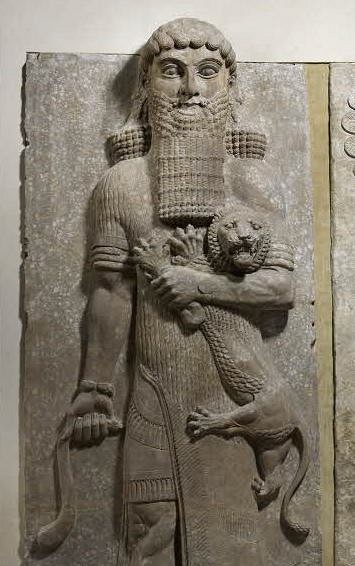
Gilgamesh is the semi-mythic King of Uruk in Mesopotamia best known from The Epic of Gilgamesh (written c. 2150 - 1400 BCE) the great Sumerian/Babylonian poetic work which pre-dates Homer ’s writing by 1500 years and, therefore, stands as the oldest piece of epic world literature.
The motif of the quest for the meaning of life is first fully explored in Gilgamesh as the hero-king leaves his kingdom following the death of his best friend, Enkidu, to find the mystical figure Utnapishtim and gain eternal life. Gilgamesh's fear of death is actually a fear of meaninglessness and, although he fails to win immortality, the quest itself gives his life meaning. This theme has been explored by writers and philosophers from antiquity up to the present day.
HISTORICAL & LEGENDARY KING
Gilgamesh's father is said to have been the Priest-King Lugalbanda (who is featured in two Sumerian poems concerning his magical abilities which pre-date Gilgamesh ) and his mother the goddess Ninsun (also known as Ninsumun, the Holy Mother and Great Queen). Accordingly, Gilgamesh was a demi-god who was said to have lived an exceptionally long life (the Sumerian King List records his reign as 126 years) and to be possessed of super-human strength.
Known as 'Bilgames' in the Sumerian, 'Gilgamos' in Greek, and associated closely with the figure of Dumuzi from the Sumerian poem The Descent of Inanna, Gilgamesh is widely accepted as the historical 5th king of Uruk who reigned in the 26th century BCE. His influence was so profound that myths of his divine status grew up around his deeds and finally culminated in the tales found in The Epic of Gilgamesh. Later Mesopotamian kings would invoke his name and associate his lineage with their own. Most famously, Shulgi of Ur (2029-1982 BCE), considered the greatest king of the Ur III Period (2047-1750 BCE) in Mesopotamia, claimed Lugalbanda and Ninsun as his parents and Gilgamesh as his brother to elevate his reign in the eyes of the people.
Known as 'Bilgames' in the Sumerian, 'Gilgamos' in Greek, and associated closely with the figure of Dumuzi from the Sumerian poem The Descent of Inanna, Gilgamesh is widely accepted as the historical 5th king of Uruk who reigned in the 26th century BCE. His influence was so profound that myths of his divine status grew up around his deeds and finally culminated in the tales found in The Epic of Gilgamesh. Later Mesopotamian kings would invoke his name and associate his lineage with their own. Most famously, Shulgi of Ur (2029-1982 BCE), considered the greatest king of the Ur III Period (2047-1750 BCE) in Mesopotamia, claimed Lugalbanda and Ninsun as his parents and Gilgamesh as his brother to elevate his reign in the eyes of the people.

Map of Sumer
DEVELOPMENT OF THE TEXT
The Akkadian version of the text was discovered at Nineveh, in the ruins of the library of Ashurbanipal, in 1849 CE by the archaeologist Austin Henry Layard. Layard's expedition was part of a mid-19th century CE initiative of European institutions and governments to fund expeditions to Mesopotamia to find physical evidence to corroborate events described in the Bible.What these explorers found instead, however, was that the Bible - previously thought to be the oldest book in the world and comprised of original stories - actually drew upon much older Sumerian myths.
The Epic of Gilgamesh did likewise as it is a compilation of tales, no doubt originally passed down orally, which was finally written down 700-1000 years after the historical king's reign. The author of the version Layard found was the Babylonian writer Shin-Leqi-Unninni (wrote 1300-1000 BCE) who was thought to be the world's first author known by name until the discovery of the works of Enheduanna (2285-2250 BCE), daughter of Sargon of Akkad. Shin-Leqi-Unninni drew upon Sumerian sources to create his story and probably had a significant number to work from as Gilgamesh had been a popular hero for centuries by the time the epic was created.
GILGAMESH RESCUES A POWERFUL & POTENT GODDESS FROM A DIFFICULT SITUATION WHICH SHOWS THE HIGH REGARD IN WHICH HE WAS HELD.
In the Sumerian tale of Inanna and the Huluppu Tree, in which the goddess Inanna plants a troublesome tree in her garden and appeals to her family for help with it, Gilgamesh appears as her loyal brother who comes to her aid.
In this story, Inanna (the Sumerian goddess of love and war ) plants a tree in her garden with the hope of one day making a chair and bed from it. The tree becomes infested, however, by a snake at its roots, a female demon ( lilitu) in its center, and an Anzu bird in its branches.
No matter what, Inanna cannot rid herself of the pests and so appeals to her brother, Utu, god of the sun, for help. Utu refuses but her plea is heard by Gilgamesh who comes, heavily armed, and kills the snake. The demon and Anzu bird then flee and Gilgamesh, after taking the branches for himself, presents the trunk to Inanna to build her bed and chair from. This is thought to be the first appearance of Gilgamesh in heroic poetry and the fact that he rescues a powerful and potent goddess from a difficult situation shows the high regard in which he was held even early on.
Other tales mentioning Gilgamesh also represent him as the great hero and the historical king was eventually accorded completely divine status as a god. He was seen as the brother of Inanna, one of the most popular goddesses, if not the most popular, in all of Mesopotamia. Prayers found inscribed on clay tablets address Gilgamesh in the afterlife as a judge in the Underworld comparable in wisdom to the famous Greek judges of the Underworld, Rhadamanthus, Minos, and Aeacus.
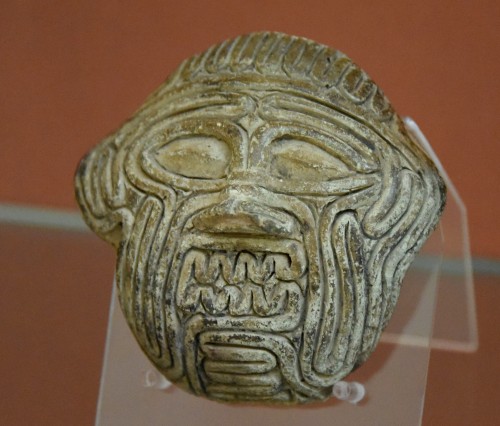
Face of the Demon Humbaba
THE EPIC TALE
In The Epic of Gilgamesh, the great king is thought to be too proud and arrogant by the gods and so they decide to teach him a lesson by sending the wild man, Enkidu, to humble him. Enkidu and Gilgamesh, after a fierce battle in which neither are bested, become friends and embark on adventures together.
They kill Humbaba, demon of the Cedar Forest, and this attracts the attention of Inanna (known by her Akkadian/Babylonian name Ishtar in the story). Inanna tries to seduce Gilgamesh but he rejects her, citing all the other men she has had as lovers who ended their lives poorly. Inanna is enraged and sends her brother-in-law, the Bull of Heaven, down to earth to destroy Gilgamesh. Enkidu comes to his friend's aid and kills the bull but, in doing so, he has offended the gods and is condemned to death.
When Enkidu dies, Gilgamesh falls into a deep grief and, recognizing his own mortality through the death of his friend, questions the meaning of life and the value of human accomplishment in the face of ultimate extinction. He cries:
How can I rest, how can I be at peace? Despair is in my heart. What my brother is now, that shall I be when I am dead. Because I am afraid of death I will go as best I can to find Utnapishtim whom they call the Faraway, for he has entered the assembly of the gods. (Sandars, 97)
Casting away all of his old vanity and pride, Gilgamesh sets out on a quest to find the meaning of life and, finally, some way of defeating death. He travels through the mountains, over vast oceans, and finally locates Utnapishtim who offers him two chances at immortality; both of which he fails. First, he cannot remain awake for six days and six nights and, second, he fails to protect a magic plant; a snake eats the plant while Gilgamesh sleeps. Failing to have won immortality, he is rowed back home by the ferryman Urshanabi and, once there, writes down his story.
LEGACY & CONTINUING DEBATE
Through his struggle to find meaning in life, Gilgamesh defied death and, in doing so, becomes the first epic hero in world literature. The grief of Gilgamesh, and the questions his friend's death evoke, resonate with every human being who has wrestled with the meaning of life in the face of death. Although Gilgamesh ultimately fails to win immortality in the story, his deeds live on through the written word and, so, does he.
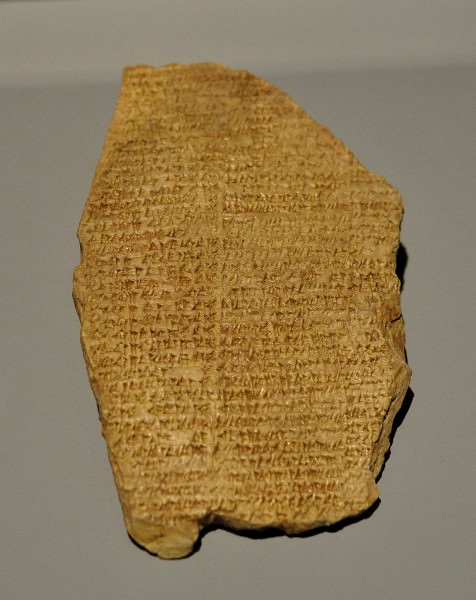
The Story of Gilgamesh and Aga
Since The Epic of Gilgamesh existed in oral form long before it was written down, there has been much debate over whether the extant tale is more early Sumerian or later Babylonian in cultural influence. The best-preserved version of the story, as noted, comes from Shin-Leqi-Unninni who most likely embellished on the original Sumerian source material. Regarding this, the Orientalist Samuel Noah Kramer writes:
Of the various episodes comprising The Epic of Gilgamesh, several go back to Sumerian prototypes actually involving the hero Gilgamesh. Even in those episodes which lack Sumerian counterparts, most of the individual motifs reflect Sumerian mythic and epic sources. In no case, however, did the Babylonian poets slavishly copy the Sumerian material. They so modified its content and molded its form, in accordance with their own temper and heritage, that only the bare nucleus of the Sumerian original remains recognizable. As for the plot structure of the epic as a whole - the forceful and fateful episodic drama of the restless, adventurous hero and his inevitable disillusionment - it is definitely a Babylonian, rather than a Sumerian, development and achievement.(History Begins at Sumer, 270).
Historical evidence for Gilgamesh's existence is found in inscriptions crediting him with the building of the great walls of Uruk (modern day Warka, Iraq) which, in the story, are the tablets upon which he first records his great deeds and his quest for the meaning of life. There are other references to him by known historical figures of his time such as King Enmebaragesi of Kish and, of course, the Sumerian King List and the legends which grew up around his reign.
A GERMAN TEAM OF ARCHAEOLOGISTS CLAIM TO HAVE DISCOVERED THE TOMB OF GILGAMESH IN APRIL OF 2003 CE.
In the present day, Gilgamesh is still spoken of and written about. A German team of Archaeologists claim to have discovered the Tomb of Gilgamesh in April of 2003 CE. Archaeological excavations, conducted through modern technology involving magnetization in and around the old riverbed of the Euphrates, have revealed garden enclosures, specific buildings, and structures described in The Epic of Gilgamesh including the great king's tomb. According to legend, Gilgmesh was buried at the bottom of the Euphrates when the waters parted upon his death.
Whether the historical king existed is no longer relevant, however, as the character has taken on a life of his own over the centuries. At the end of the story, when Gilgamesh lays dying, the narrator says:
The heroes, the wise men, like the new moon have their waxing and waning. Men will say, "Who has ever ruled with might and with power like [Gilgamesh]?" As in the dark month, the month of shadows, so without him there is no light. O Gilgamesh, you were given the kingship, such was your destiny, everlasting life was not your destiny. Because of this, do not be sad at heart, do not be grieved or oppressed; he has given you power to bind and to loose, to be the darkness and the light of mankind. (Sanders, 118)
The story of Gilgamesh's failure to realize his dream of immortality is the very means by which he attains it. The epic itself is immortality and has served as the model for any similar tale which has been written since. It was no doubt widely read prior to the fall of the Assyrian Empire in 612 BCE and has become increasingly popular and influential since its rediscovery in 1879 CE.
Gilgamesh encourages hope in that, even though one may not be able to live forever, the choices one makes in life resonate in the lives of others. These others may be friends, family, acquaintances, or may be strangers living long after one's death who continue to be touched by the eternal story of the hero's refusal to accept a life without meaning. Gilgamesh's struggle against apparent meaninglessness defines him - just as it defines anyone who has ever lived - and his quest continues to inspire those who recognize how eternal and intrinsically human that struggle is.
The Library of Hadrian, Athens › Antique Origins
Ancient Civilizations
The Library of Hadrian (aka Hadrian's Library) in Athens was constructed circa 132-134 CE as part of Roman EmperorHadrian's grand re-building plan for the city. The library was the largest in Athens and with its columned façade and high surrounding walls, built to impress. The building was used to store important literary works and legal and administrative documents as well as offer a place to hear lectures and host various philosophical schools.
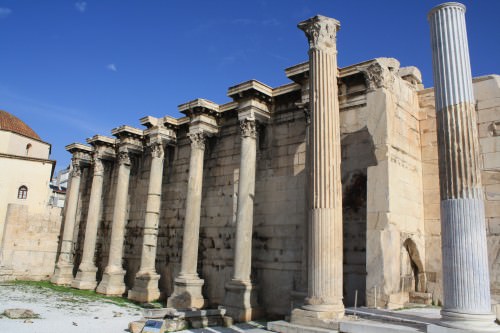
Facade, Library of Hadrian, Athens
HISTORICAL OVERVIEW
Located just outside the northern corner of the Roman Agora, the library was built on the site of Late Hellenistic and Early Roman housing. Becoming the largest library in Athens it was built to house not only books but also as a repository for the official state archives. Several important schools of learning and philosophy also occupied the building.
LIBRARIES WERE A PLACE TO HEAR LECTURES AND DISCUSS INTELLECTUAL MATTERS WITH FELLOW VISITORS IN THE TRANQUILITY OF THE LIBRARY GARDEN.
Libraries in antiquity were not generally used as lending libraries but rather as places of study and storage. Documents were usually in the form of papyrus scrolls which were kept in partitioned wooden cupboards ( armaria ) set in niches in the walls of the room. Libraries were also a place to hear lectures and orators, and discuss intellectual matters with fellow visitors in the tranquility of the library garden. The Library of Hadrian was famously described by Pausanias as "the building with 100 columns of Phrygian marble, with halls with painted ceilings, alabaster walls, and niches with statues, in which books were kept" ( Attica ).
During the invasion by the Heruli in 267 century CE, the library suffered notable damage and in 277 CE, when the city sought to better protect itself, the library was made part of a fortification wall. The library was renovated by Herculius (407-12 century CE), the Prefectus (Eparch) of the Illyricum, and a statue of him was erected at the building's entrance. The inscription related to this statue is still visible on the left side of the entrance. It is possible that at the same time an early Christian church was built in the central garden space, although this four-apse structure may have been built in the mid-5th century CE. This Christian church, Athens' first in fact, was destroyed in the 6th century CE and so replaced by a large three-aisled basilica.
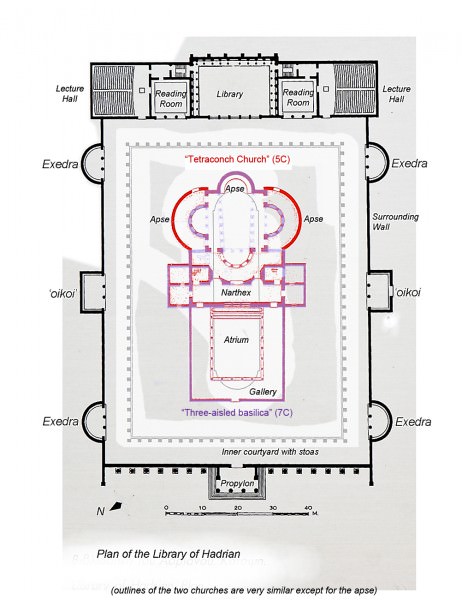
Plan of Hadrian's Library
LAYOUT & DIMENSIONS
Built on a rectangular plan the peristyle-formed library measured 122 x 82 m. The impressive entrance, located on the west side of the building, had a Corinthian columned porch ( propylon ). This was built in the centre of a columned façade with seven Corinthian columns in green Karystos marble either side of the entrance doorway. These columns may originally have had statues above them backed by a solid wall of Pentelic marble. The entrance was given even greater grandeur by clearing a 22 metre-wide courtyard space immediately in front of the building.
The large interior courtyard was surrounded by colonnades with 100 columns whilst the exterior of the library presented a high plain wall of poros blocks. The courtyard had exedrae (semi-circular seating spaces) at each corner with oikoi (rectangular spaces) at the centre points. In the centre of the courtyard was a garden and decorative pool. An inscription at the site indicates that the library was open 'from the first hour until the sixth'.
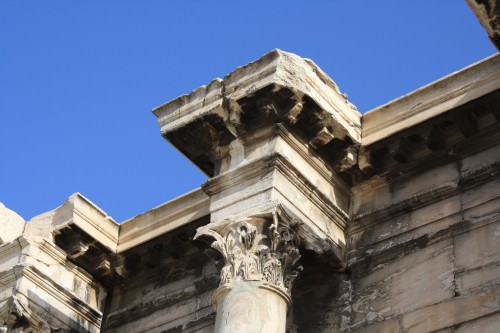
Capital, Library of Hadrian
The main part of the building was opposite the entrance on the eastern side. Here in the centre was the square library itself with a reading room on either side and a lecture hall ( auditorium ) at each end of the wing. The lecture halls each had rows of curved seating rising as in an amphitheatre. The structure originally had a second floor or attic with a gallery looking down on the lower floor and with more niches for the storage of books and documents.
LATER HISTORY
Like many ancient buildings the library complex saw an eventful and chequered history in the last 1000 years. The large 7th century CE basilica at the site was destroyed by fire in the 11th century CE and so was replaced by another basilica, the Megali Panagia, in the 12th century CE, only this time on a smaller scale with only a single aisle. Contemporary with this new cathedral was a smaller church, the Agios Asomatos sta Skalia dedicated to the Archangel Michael which was built near the entrance.
When Athens came under Turkish control the library was once again used as a centre of administration and became the residence of the Turkish Administrator of Athens. From the 15th century CE it was also the site of two important bazaars and some residential buildings. During the 18th century CE the building served both as a mosque and as a fortress. A tower was built in 1814 CE which would later carry a clock given by Lord Elgin and in the 19th century CE the library saw service as an army barracks and then as a prison.
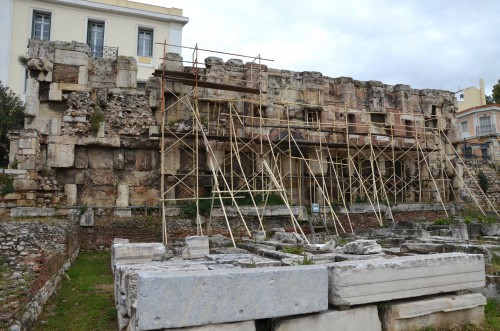
Library of Hadrian, East Wall
Excavations at the site began in the late 19th century CE but it was not until the second half of the 20th century CE that the later buildings were cleared from the site and an attempt was made to restore parts of the library to its original form. Today the entrance façade survives in sufficient form (including restorations) to give an idea of the scale of the building and part of the interior wall of the east wing still stands where one can see some of the original niches for documents. The bench supports of the northeast lecture hall, including the curved stone first row, are also still in situ. Finally, architectural elements of the various churches built in the central courtyard are still visible, including portions of their mosaic flooring.
LICENSE:
Article based on information obtained from these sources:with permission from the Website Ancient History Encyclopedia
Content is available under License Creative Commons: Attribution-NonCommercial-ShareAlike 3.0 Unported. CC-BY-NC-SA License